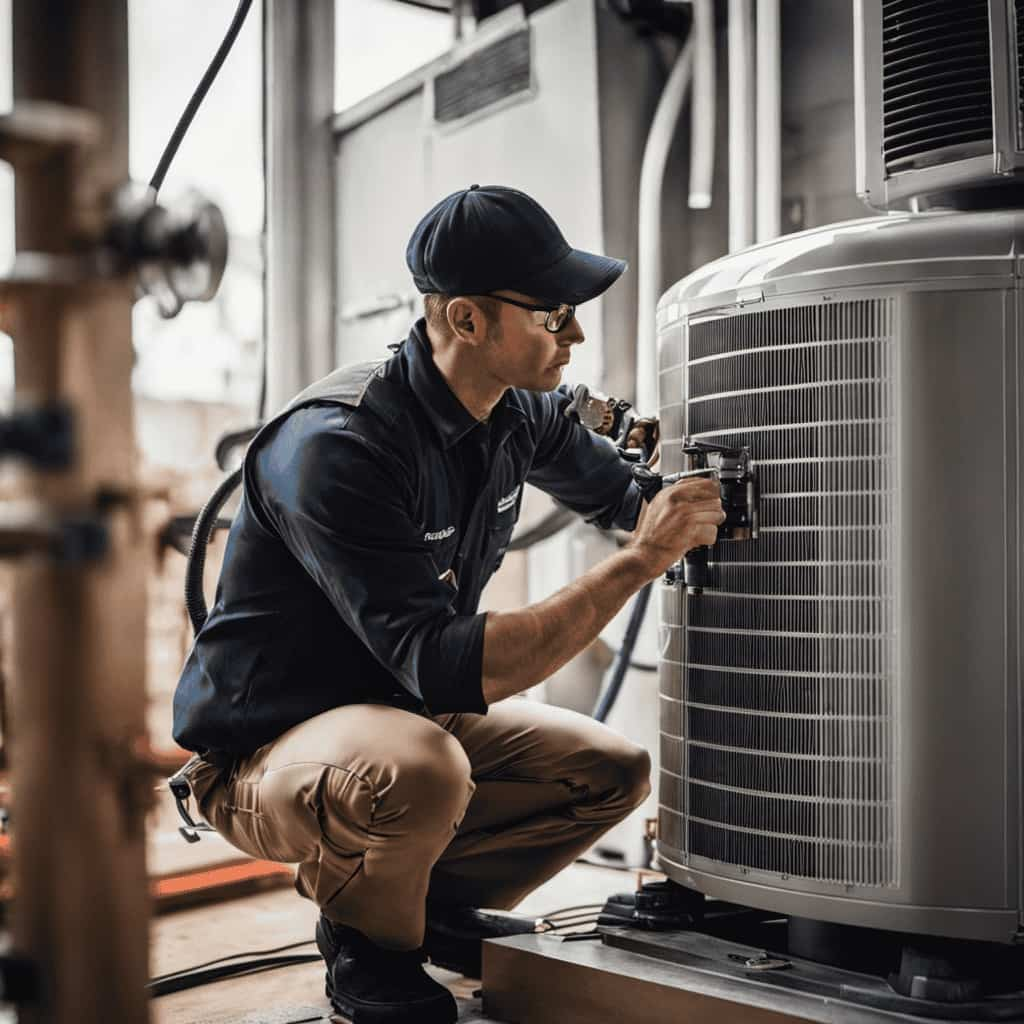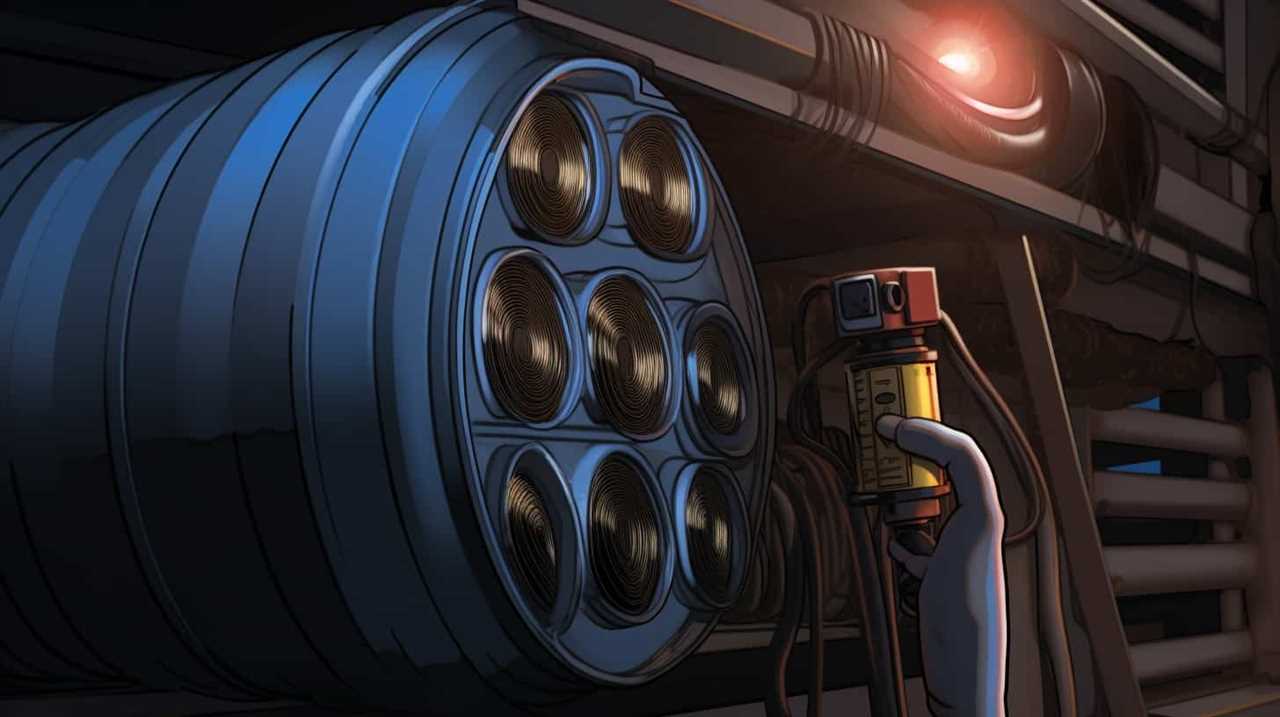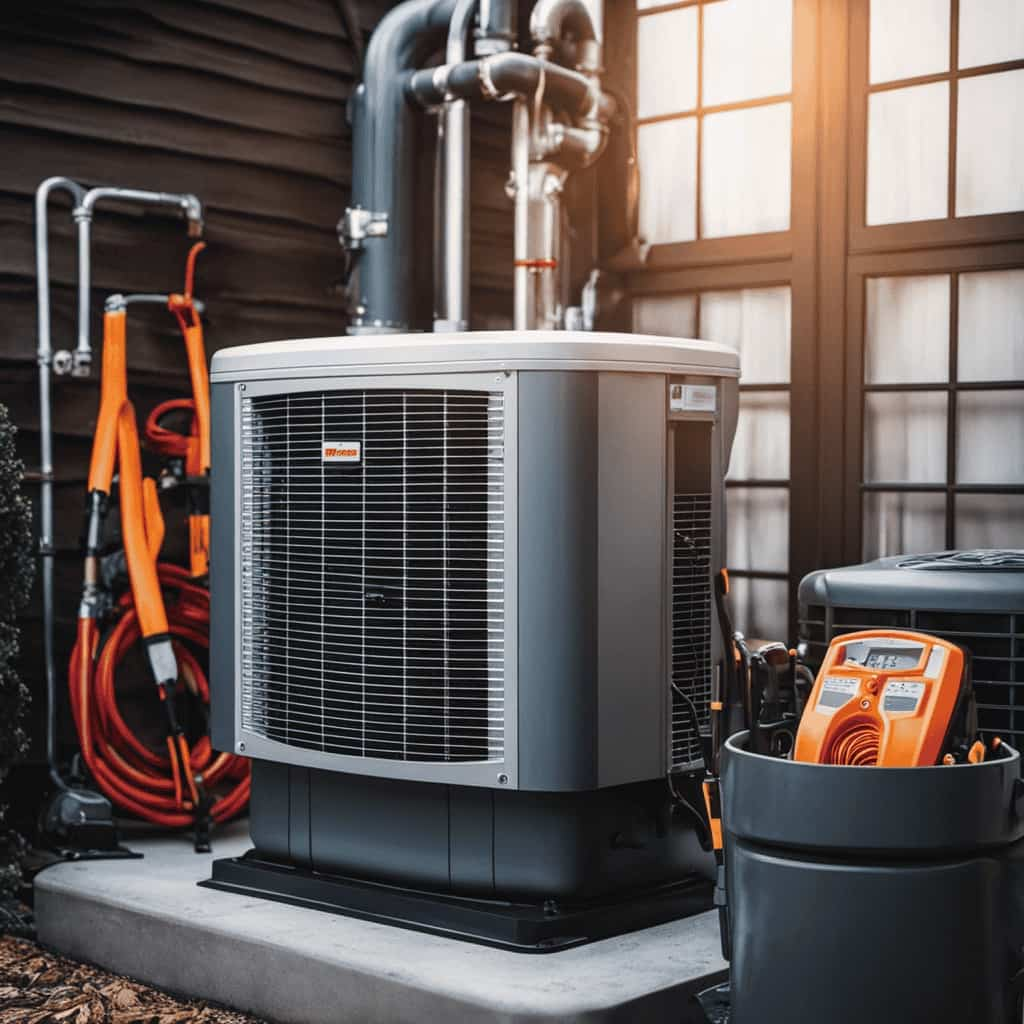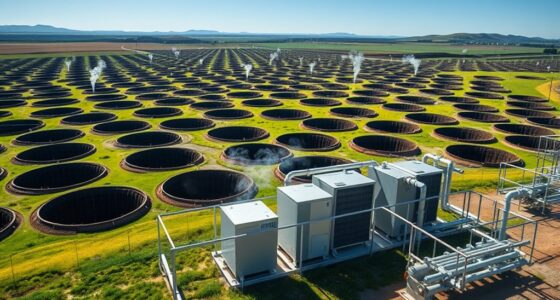
Curious about how geothermal heat pumps work? No problem! We have all the information you need!
In this article, we’ll take you on a journey to discover the authentic insights into geothermal heat pump operations. From understanding the technology to exploring the benefits and even troubleshooting common challenges, we’ll provide you with all the intimate details you need.
So, buckle up and get ready to dive deep into the fascinating world of geothermal heat pumps!
Key Takeaways
- Geothermal heat pump technology utilizes the constant temperature of the Earth to efficiently heat and cool buildings.
- The main components of a geothermal heat pump system are the ground loop, the heat pump unit, and the distribution system.
- Geothermal heat pump systems offer energy efficiency, significantly reducing heating and cooling costs.
- Regular maintenance is key to ensuring optimal performance of geothermal heat pump systems.
The Basics of Geothermal Heat Pump Technology
We will now cover the three main components of geothermal heat pump technology.
The first component is the ground loop system, which consists of a series of pipes buried underground. These pipes circulate a mixture of water and antifreeze, absorbing heat from the earth in winter and transferring it to the heat pump inside the house. In the summer, the ground loop system extracts heat from the house and deposits it back into the earth.
The second component is the heat pump unit itself, which uses a compressor and a refrigerant to transfer heat between the ground loop system and the building.
Finally, we have the distribution system, which includes ductwork or radiant flooring to distribute the conditioned air throughout the space.
Understanding these three components is essential to grasp the functioning of geothermal heat pump technology.

Understanding the Components of a Geothermal Heat Pump System
Let’s delve into the key components of a geothermal heat pump system.
To understand how this system works, it’s important to know its main components: the ground loop, the heat pump unit, and the distribution system.
The ground loop consists of pipes buried underground that transfer heat to and from the earth.
The heat pump unit, usually located indoors, extracts heat from the ground loop and distributes it throughout the building. It also has a compressor, condenser, and evaporator to facilitate the heat transfer process.

The distribution system circulates the heated or cooled air through the building, ensuring a comfortable environment.
Now that we understand the components of a geothermal heat pump system, let’s move on to exploring the benefits of this sustainable heating and cooling solution.
Exploring the Benefits of Geothermal Heat Pump Systems
Let’s talk about the benefits of geothermal heat pump systems.
One of the key advantages is their energy efficiency, which can significantly reduce heating and cooling costs.

Additionally, these systems offer the potential for long-term cost savings, as they require less maintenance and have a longer lifespan.
Another important benefit is their positive impact on the environment, as geothermal heat pumps produce lower greenhouse gas emissions compared to traditional heating and cooling methods.
Energy Efficiency Advantages
Exploring the energy efficiency advantages of geothermal heat pump systems, we can see how they offer significant savings on energy consumption. These systems utilize the natural heat stored in the earth to provide heating and cooling for homes and buildings.
By extracting heat from the ground during the winter and releasing it back during the summer, geothermal heat pumps can reduce energy usage by up to 70% compared to traditional heating and cooling systems. This not only leads to lower utility bills but also helps to reduce greenhouse gas emissions, making geothermal heat pumps an environmentally friendly choice.

Additionally, these systems require minimal maintenance and have a long lifespan, further adding to their cost-effectiveness. With geothermal heat pump systems, homeowners can enjoy the intimacy of a comfortable indoor environment while saving money and contributing to a sustainable future.
Cost Savings Potential
By maximizing energy efficiency and minimizing operational costs, geothermal heat pump systems offer significant cost savings potential for homeowners.
Here are some ways in which these systems can help you save money:
-
Lower energy bills: Geothermal heat pumps use the stable temperature of the earth to heat and cool your home, reducing the need for traditional heating and cooling methods. This can result in substantial savings on your energy bills.

-
Reduced maintenance costs: Compared to other heating and cooling systems, geothermal heat pumps have fewer moving parts, which means less maintenance and fewer repair costs over time.
-
Longer lifespan: Geothermal heat pumps generally have longer lifespans than traditional HVAC systems, saving you money on replacement costs.
-
Potential tax incentives: In some areas, homeowners may be eligible for tax incentives or rebates for installing geothermal heat pump systems, further reducing the overall cost.
Environmental Sustainability Benefits
We can contribute to environmental sustainability by reducing greenhouse gas emissions and reliance on fossil fuels through the utilization of geothermal heat pump systems. By harnessing the Earth’s natural heat, these systems provide a more efficient and cleaner way to heat and cool our homes.

Geothermal heat pumps use a small amount of electricity to transfer heat from the ground or water to the interior of a building, providing both heating and cooling. This process significantly reduces the need for traditional heating systems that rely on burning fossil fuels, which release harmful greenhouse gases into the atmosphere.
Additionally, geothermal heat pumps have a longer lifespan than conventional systems, reducing waste and the need for replacements.
Step-by-Step Guide to Installing a Geothermal Heat Pump System
Let’s start by outlining each step involved in installing a geothermal heat pump system. Here’s a breakdown of what you can expect:
-
Site Evaluation: A thorough assessment of your property will be conducted to determine its suitability for geothermal heat pump installation. This includes analyzing soil conditions, available space, and accessibility.

-
Design and Equipment Selection: Based on the site evaluation, a customized system design will be created to meet your specific heating and cooling needs. The appropriate equipment, including the heat pump unit and ground loop system, will be selected.
-
Installation: Skilled technicians will install the heat pump unit, ground loop system, and all necessary components. This typically involves drilling boreholes or trenches for the ground loop installation and connecting the system to your existing ductwork or radiant heating system.
-
Commissioning and Testing: Once the installation is complete, the system will be commissioned and thoroughly tested to ensure optimal performance and efficiency.
How Geothermal Heat Pumps Harness Renewable Energy
Geothermal heat pumps harness renewable energy from the earth’s natural heat source through the use of a series of underground pipes. These pipes circulate a fluid, usually water or a mixture of water and antifreeze, which absorbs the heat from the ground.

As the fluid travels through the pipes, it transfers the heat to a heat exchanger in the heat pump system. The heat pump then amplifies the heat and distributes it throughout the building via a forced-air or hydronic system.
This process allows geothermal heat pumps to efficiently heat and cool spaces while reducing the reliance on non-renewable energy sources. By tapping into the earth’s natural heat, geothermal heat pumps provide a sustainable and environmentally friendly solution for heating and cooling needs.
Maximizing Energy Efficiency With Geothermal Heat Pump Operations
Let’s talk about how we can maximize energy efficiency with geothermal heat pump operations.
Two key factors that play a crucial role in energy efficiency are optimal temperature settings and maintenance best practices.

Optimal Temperature Settings
To maximize energy efficiency with geothermal heat pump operations, it’s important to determine the optimal temperature settings. Here are some tips to help you find the right temperature for your geothermal heat pump:
-
Set your thermostat to a comfortable temperature during the day, but consider lowering it a few degrees at night when you’re asleep. This can help save energy without sacrificing comfort.
-
Take advantage of programmable thermostats, which allow you to schedule temperature adjustments throughout the day. By reducing the temperature when you’re away from home or during periods of inactivity, you can further optimize energy usage.
-
Consider the weather outside when adjusting your temperature settings. On milder days, you may be able to set your thermostat a bit higher in the winter or lower in the summer, reducing the workload on your heat pump.

-
Regularly monitor and adjust your temperature settings based on your energy usage and comfort levels. Experiment with different settings to find what works best for you.
Maintenance Best Practices
Regular maintenance is essential for maximizing energy efficiency with geothermal heat pump operations. By following a few best practices, you can ensure that your system runs smoothly and efficiently. Here are some tips to keep in mind:
| Maintenance Task | Frequency | Importance |
|---|---|---|
| Filter cleaning/replacement | Every 1-3 months | Keeps air flowing freely and prevents strain on the system |
| Inspecting ductwork | Annually | Identifies leaks or damage that can affect efficiency |
| Checking refrigerant levels | Every 2-3 years | Ensures proper heat transfer and prevents compressor damage |
These simple maintenance tasks can have a significant impact on the performance and energy efficiency of your geothermal heat pump system. By taking the time to perform these tasks regularly, you can enjoy optimal comfort and savings. Now, let’s explore the role of ground loops in geothermal heat pump systems.
The Role of Ground Loops in Geothermal Heat Pump Systems
What are the key functions of ground loops in geothermal heat pump systems?

Ground loops play a vital role in the operation of geothermal heat pump systems. Here are the key functions of ground loops:
-
Heat Exchange: Ground loops are responsible for transferring heat between the earth and the heat pump system. They extract heat from the ground during the heating season and release heat into the ground during the cooling season.
-
Energy Efficiency: Ground loops help maximize the energy efficiency of geothermal heat pump systems. By utilizing the stable temperature of the earth, they reduce the energy required to heat and cool buildings, resulting in lower utility bills.
-
Longevity: Ground loops are designed to be durable and long-lasting. Properly installed and maintained ground loops can have a lifespan of up to 50 years, making them a reliable and cost-effective solution for heating and cooling.

-
Environmental Benefits: Ground loops have minimal environmental impact. They use the renewable energy stored in the earth and produce no greenhouse gas emissions, helping to reduce carbon footprint and protect the environment.
Understanding the important role of ground loops in geothermal heat pump systems is essential for maximizing the efficiency and effectiveness of these sustainable heating and cooling solutions.
Common Challenges and Solutions in Geothermal Heat Pump Operations
Now let’s address some of the common challenges that may arise in geothermal heat pump operations and explore potential solutions.
By discussing installation best practices, we can ensure that the system is set up correctly from the start, minimizing future issues.

Additionally, we’ll provide energy efficiency tips to optimize the performance of the heat pump and reduce energy consumption.
Lastly, troubleshooting common issues will help readers identify and resolve any problems that may occur during operation.
Installation Best Practices
When installing geothermal heat pump systems, we often encounter challenges such as limited space and difficult site conditions, but by following best practices and implementing innovative solutions, we can ensure successful operations.
Here are some installation best practices that we’ve found to be effective:

-
Proper system sizing: Ensuring the right size of the geothermal heat pump system is critical for optimal performance and efficiency.
-
Thorough site assessment: Conducting a detailed site assessment helps identify any potential obstacles or limitations that may affect the installation process.
-
Careful loop design: Designing the loop system with precision and considering factors such as soil conditions and loop configuration is crucial for long-term performance.
-
Skilled installation team: Having a skilled and experienced installation team is key to overcoming challenges and ensuring a seamless installation process.

Energy Efficiency Tips
We have discovered that optimizing insulation levels and regularly maintaining the system can greatly enhance the energy efficiency of geothermal heat pump operations.
When it comes to energy efficiency, there are a few common challenges that geothermal heat pump operators often face. One challenge is inadequate insulation, which can result in heat loss and reduced efficiency. To overcome this challenge, it’s important to ensure that the insulation is of high quality and properly installed.
Another challenge is neglecting regular maintenance, which can lead to decreased performance and increased energy consumption. By scheduling regular maintenance checks and cleaning the system, operators can ensure that their geothermal heat pump operates at optimal efficiency.
Troubleshooting Common Issues
One common issue that geothermal heat pump operators often encounter is a lack of heat transfer, which can be solved by checking and cleaning the heat exchanger. When the heat exchanger becomes dirty or clogged, it hinders the efficient transfer of heat between the ground and the heat pump system.

To troubleshoot this issue, we recommend the following steps:
- Inspect the heat exchanger for any signs of dirt, debris, or mineral buildup.
- Use a soft brush or a vacuum cleaner to carefully clean the heat exchanger surfaces.
- Check the flow rate of the heat transfer fluid and ensure it’s within the recommended range.
- Consider implementing a regular maintenance schedule to prevent future heat exchanger issues.
Maintaining and Troubleshooting Geothermal Heat Pump Systems
Our team is responsible for maintaining and troubleshooting geothermal heat pump systems. We understand the importance of keeping these systems running smoothly to ensure optimal performance and energy efficiency. Regular maintenance is key to preventing issues and prolonging the lifespan of the equipment.
This includes checking and cleaning filters, inspecting and lubricating moving parts, and testing the system’s performance. In the event of a malfunction or breakdown, our team is skilled in identifying and resolving the problem quickly and efficiently. We’ve the expertise to troubleshoot issues such as low refrigerant levels, faulty thermostats, or compressor failures.
Our goal is to provide reliable and effective maintenance and troubleshooting services, ensuring that your geothermal heat pump system continues to operate at its best.

Comparing Geothermal Heat Pump Systems to Traditional HVAC Systems
When comparing geothermal heat pump systems to traditional HVAC systems, there are several key factors to consider.
-
Efficiency: Geothermal heat pump systems are known for their high efficiency, providing significant energy savings compared to traditional HVAC systems.
-
Environmental impact: Geothermal heat pump systems use renewable energy from the ground, making them more environmentally friendly and reducing carbon emissions.
-
Longevity: Geothermal heat pump systems have a longer lifespan than traditional HVAC systems, requiring less maintenance and replacement over time.

-
Cost-effectiveness: Although geothermal heat pump systems have higher upfront costs, their long-term energy savings and lower maintenance expenses make them a cost-effective choice.
Considering these factors, geothermal heat pump systems offer an intimate and sustainable solution to heating and cooling needs, providing both comfort and energy efficiency for homeowners.
Case Studies: Real-world Examples of Geothermal Heat Pump Success Stories
By examining real-world examples, we can gain authentic insights into the success stories of geothermal heat pump operations. These case studies provide valuable information about the benefits and practical applications of geothermal heat pump systems. Let’s take a look at some real-life examples:
| Case Study | Location | Description | Benefits |
|---|---|---|---|
| Green Residence | California | The Green Residence installed a geothermal heat pump system to replace their traditional HVAC system. They experienced significant energy savings, with their monthly utility bills reduced by 50%. The system also provided consistent heating and cooling throughout the year. | – 50% energy savings |
- Consistent heating and cooling
- Reduced carbon footprint |
| Smith Office Building | New York | The Smith Office Building implemented a geothermal heat pump system for their heating and cooling needs. They saw a drastic reduction in maintenance costs and improved indoor air quality. The system also allowed for individual temperature control in different zones of the building. | – Lower maintenance costs - Improved indoor air quality
- Individual temperature control |
These case studies demonstrate the practicality and effectiveness of geothermal heat pump systems in different settings. They highlight the cost savings, comfort, and environmental benefits that can be achieved through the adoption of this sustainable technology.

Frequently Asked Questions
Can Geothermal Heat Pump Systems Be Used in All Types of Climates?
Yes, geothermal heat pump systems can be used in all types of climates. They provide efficient heating and cooling by utilizing the constant temperature of the earth. It’s a reliable and sustainable solution for any climate.
How Long Do Geothermal Heat Pump Systems Typically Last?
Geothermal heat pump systems typically last for about 20 to 25 years. It’s fascinating to think about the long-term benefits of investing in this technology, especially when considering its efficiency and environmental friendliness.
Are Geothermal Heat Pump Systems Noisy?
Yes, geothermal heat pump systems can be noisy. However, advancements in technology have made them much quieter than older models. Regular maintenance and proper installation can further reduce any noise produced by the system.
Can Geothermal Heat Pump Systems Be Installed in Existing Homes or Only in New Construction?
Yes, geothermal heat pump systems can be installed in existing homes. We’ve researched this question thoroughly and can confirm that retrofitting existing homes with geothermal systems is a viable option for homeowners.

Do Geothermal Heat Pump Systems Require a Backup Heating Source in Extreme Cold Climates?
Yes, geothermal heat pump systems do require a backup heating source in extreme cold climates. This ensures that the system can still provide warmth when temperatures drop significantly, maintaining comfort in our homes.
Conclusion
In conclusion, geothermal heat pump systems offer a multitude of benefits and are a sustainable solution for heating and cooling. With their efficient operation and renewable energy source, they provide a viable alternative to traditional HVAC systems.
However, it’s important to acknowledge the challenges and maintenance requirements that come with these systems. Despite the occasional setbacks, the long-term benefits and success stories of geothermal heat pumps make them a worthwhile investment for a greener future.









